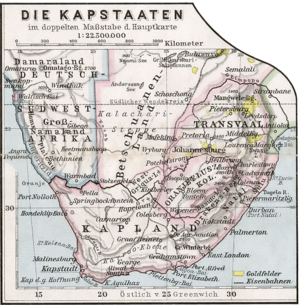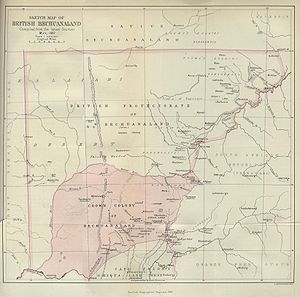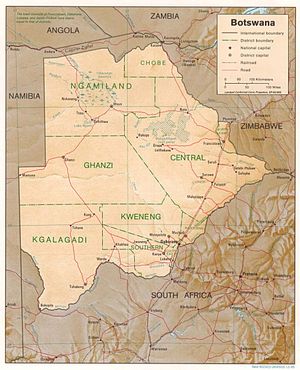
History of Botswana
Background to the schools Wikipedia
This wikipedia selection has been chosen by volunteers helping SOS Children from Wikipedia for this Wikipedia Selection for schools. Sponsor a child to make a real difference.
The Batswana, a term also used to denote all citizens of Botswana, refers to the country's major ethnic group (called the "Tswana" in South Africa). Prior to European contact, the Batswana lived as herders and farmers under tribal rule.
Before European contact
Sometime between 200-500 CE, Bantu speaking peoples, who originated in the Katanga area (today part of the DRC and Zambia), and had been expanding across sub-Saharan Africa, crossed the Limpopo River, entering the area today known as South Africa.
There were 2 broad waves of immigration to South Africa; Nguni and Sotho-Tswana. The former settled in the eastern coastal regions, while the latter settled primarily in the area known today as the Highveld — the large, relatively high central plateau of southern Africa.
By 1000AD the Bantu colonization of most of South Africa had been completed, with the possible exception of what is now the Western Cape and the Northern Cape, which are believed to have been inhabited by Khoisan people until Dutch colonisation. The Bantu-speaking society was highly a decentralized feudal society organized on a basis of kraals (an enlarged clan), headed by a chief, who owed a very hazy allegiance to the nation's head chief. According to Neil Parsons's online "Brief History of Botswana":
| “ | "From around 1095 south-eastern Botswana saw the rise of a new culture, characterized by a site on Moritsane hill near Gabane, whose pottery mixed the old western style with new Iron Age influences derived from the eastern Transvaal (Lydenburg culture). The Moritsane culture is historically associated with the Khalagari (Kgalagadi) chiefdoms, the westernmost dialect-group of Sotho (or Sotho-Tswana) speakers, whose prowess was in cattle raising and hunting rather than in farming. In east-central Botswana, the area within 80 or 100 kilometres of Serowe (but west of the railway line) saw a thriving farming culture, dominated by rulers living on Toutswe hill, between about 600-700AD and 1200-1300AD. The prosperity of the state was based on cattle herding, with large corrals in the capital town and in scores of smaller hill-top villages. (Ancient cattleandsheep/goatcorrals are today revealed by characteristic grassgrowing on them.) The Toutswe people were also hunting westwards into the Kalahari and trading eastwards with the Limpopo. East coast shells, used as trade currency, were already being traded as far west as Tsodilo by 700AD. The Toutswe state appears to have been conquered by its Mapungubwe state neighbour, centred on a hill at the Limpopo-Shashe confluence, between 1200AD and 1300AD. Mapungubwe had been developing since about 1050AD because of its control of the early gold trade coming down the Shashe, which was passed on for sale to sea traders on the Indian Ocean. The site of Toutswe town was abandoned, but the new rulers kept other settlements going - notably Bosutswe, a hill-top town in the west, which supplied the state with hunting products, caught by Khoean hunters, and with Khoesan cattle given in trade or tribute from the Boteti River. But Mapungubwe's triumph was short-lived, as it was superseded by the new state of Great Zimbabwe, north of the Limpopo River, which flourished in control of the gold trade from the 13th to the 15th centuries. It is not known how far west the power of Great Zimbabwe extended. Certainly its successor state, the Butua state based at Kame near Bulawayo in western Zimbabwe from about 1450 onwards, controlled trade in salt and hunting dogs from the eastern Makgadikgadi pans, around which it built stone- walled command posts." |
” |
19th century
In the late 19th century, hostilities broke out between the Shona inhabitants of Botswana and Ndebele tribes who were migrating into the territory from the Kalahari Desert. Tensions also escalated with the Boer settlers from the Transvaal. After appeals by the Batswana leaders Khama III, Bathoen and Sebele for assistance, the British Government on 31 March 1885 put " Bechuanaland" under its protection. The northern territory remained under direct administration as the Bechuanaland Protectorate and is today's Botswana, while the southern territory became part of the Cape Colony and is now part of the northwest province of South Africa; the majority of Setswana-speaking people today live in South Africa. The Tati Concessions Land, formerly part of the Matabele kingdom, was administered from the Bechuanaland Protectorate after 1893, to which it was formally annexed in 1911.
20th century
When the Union of South Africa was formed in 1910 out of the main British colonies in the region, the Bechuanaland Protectorate, Basutoland (now Lesotho), and Swaziland (the "High Commission Territories") were not included, but provision was made for their later incorporation. However, a vague undertaking was given to consult their inhabitants, and although successive South African governments sought to have the territories transferred, Britain kept delaying, and it never occurred. The election of the National Party government in 1948, which instituted apartheid, and South Africa's withdrawal from the Commonwealth in 1961, ended any prospect of incorporation of the territories into South Africa.
An expansion of British central authority and the evolution of tribal government resulted in the 1920 establishment of two advisory councils representing Africans and Europeans. Proclamations in 1934 regularized tribal rule and powers. A European-African advisory council was formed in 1951, and the 1961 constitution established a consultative legislative council.
In June 1964, Britain accepted proposals for democratic self-government in Botswana. The seat of government was moved from Mafikeng in South Africa, to newly established Gaborone in 1965. The 1965 constitution led to the first general elections and to independence on 30 September 1966. Seretse Khama, a leader in the independence movement and the legitimate claimant to the Ngwato chiefship, was elected as the first president, re-elected twice, and died in office in 1980. The presidency passed to the sitting vice president, Ketumile Masire, who was elected in his own right in 1984 and re-elected in 1989 and 1994. Masire retired from office in 1998. The presidency passed to the sitting vice president, Festus Mogae, who was elected in his own right in 1999 and re-elected in 2004. In April 2008, Vice President Lt. Gen. Seretse Khama Ian Khama ( Ian Khama), son of Seretse Khama the first president, succeeded to the presidency when Festus Mogae retired.



